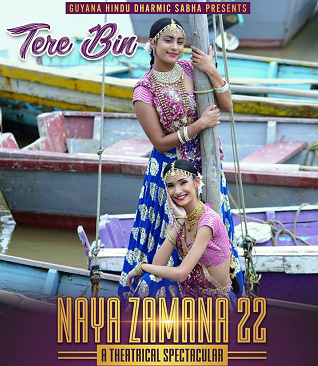
The production benefited from vibrant costuming and set design by Trishala Simantini Persaud. What was very significant for the cultural centre stage, was that the sound quality was consistent and clear, provided by Varun Samlall. Of similar relevance to the NCC stage, lighting was equally outstanding, provided by Travelling Sound and Lighting. The high quality of both was well above the norm and the capabilities of the cultural centre facilities in their usual state of disrepair.
Another significant factor of Naya Zamana was its acknowledgement of assistance given by a number of private sector agencies and individuals who most likely provided various levels of sponsorship. It was good to see that level of response to the arts from a sector that does not show such interest on a large scale and whose contribution is usually described as hard to obtain by theatre producers.
It was therefore an exemplary production in those ways, achieving what many others would be delighted to achieve. Dr Persaud obviously brought in private professional equipment and technicians to ensure consistent quality and boost stage effects. This, no doubt, helped to make Naya Zamana a very expensive production, and this is where the sponsorship came in.
But it was exemplary in a number of other ways. There was a very large cast of dancers and support performers, who were all quite well managed on stage. This had to have made telling demands on directing, stage management and choreography. Dr Persaud therefore achieved a great deal in those areas with effective support from the stage management staff.
There was great strength in dance. There was variety – vivacity, energy, effervescence and flamboyance. Dr Persaud commented: “I have pushed the dancers to try different styles of dance. Thank you to Dr Indira Harry for her choreography of ‘Selfish’ by Atif Aslam in contemporary style”. And indeed, dance was the greatest success of the performance and added much depth to the text.
Tere Bin was a dance drama and a romance. It may be valued for the way dance carried plot, mood, spectacle, atmosphere and theme. Spectacle, which was very important to the production, was particularly strong. This was shaped from Indian dance theatre and from Bollywood, and the brand of spectacle on which these forms thrive was much in evidence.
There were several choreographies in a variety of styles, but all characterized by high energy and sharpness of pace. The presentation was enhanced by the other technical elements that can create spectacle. First, there was the element of dance, already mentioned as vital to the form. The costuming overall, including the dancers and the actors, was precise, very carefully selected. Colour and visual effect were paramount as is standard in Indian dance theatre.
This was effectively supported by both light and sound. The lighting was not complex, but contributed to the colour and the mood while complementing the set. It made its contribution to the general spectacle.
Next was the set, which was another spectacular factor. Again, there was no complexity, but little dependence on realism. Set changes were representative and suggestive of place rather than explicitly naturalistic. The changes were also fairly light and easily managed, contributing to pace and fluency.
The next factor in the Indian dance drama was the music. This was quite vibrant and effective because of the clean sound quality and the high energy. But the selections also made a difference. They provided bases for the choreography, the tone and atmosphere. After all that, the dances followed appropriately, flowing on the streams of choreography.
The Bollywood influence was also always in evidence in both content and delivery. There might have been a particular effort to sustain the qualities of the Bollywood film in the structure and presentation of this drama. All the elements of spectacle are equally relevant to the form, as well as the story that they support. The uses of music, dance, colour and visual characteristics are all important to the type, but so is the drama.
Tere Bin has a romantic centre, but has thematic concerns carried by its plot. Like the film, it has romance, but also serious conflict and a touch of humour. The plot surrounds two sisters – Simran, played by Aliyah Hassan and Ahaana, played by Anusha Doodnauth initiated early into the theatre and dance. While Simran’s star rises meteorically and she becomes an award-winning celebrity, Ahanna can only dream to one day share that glamour. The reversal of fortune comes when Simran becomes too conceited and selfish for her own good, or for the good of her sister, their family and the bond between the sisters becomes strained with mild tension and rivalry, but the denouement leads to a resolution when Ahaana finally gets the chance to rise out of her sister’s shadow and achieve equal success of her own. There was also the typical romantic interest in the sub-plots and it brought a happy ending for both girls.
Among the values of the drama was the fact that Simran had to learn to become a better person, to appreciate people and to care for her sister in order to achieve more than superficiality. The vein of humour was mostly carried by the TV hostess Amber Piaralall, a kind of chorus-narrator-commentator, who offered for the most part an ironic chorus evoking much laughter.
An interesting achievement was the effectiveness of the youngest members of the cast – Saanvi Dukhbhanjan as the young Ahaana and Renuka Muniram as the young Simran.
The other members of the acting cast were Travez Piaralall as Sameer, Deepta Banik as Viren, Angelina Leitch as Mom and Gina Arjoon as the dance teacher.
Trishala Persaud and Indhira Harry led a host of dancers who carried the play through the several dance sequences that enriched the theatrical effectiveness and lent a spectrum of inter-changing colours to the spectacle and the range of tones and moods of the drama. They proved a disciplined cast and performed as a team.






